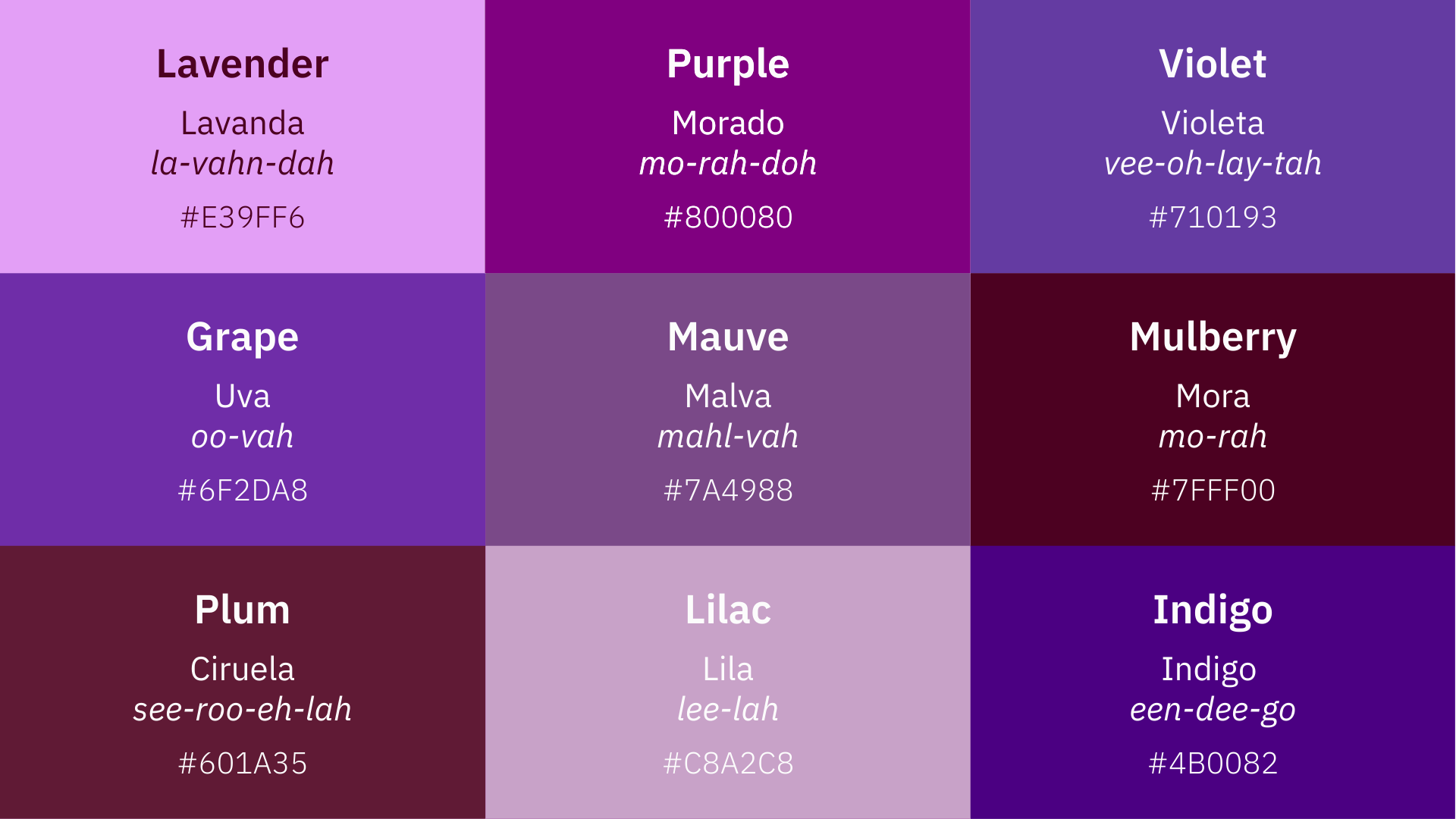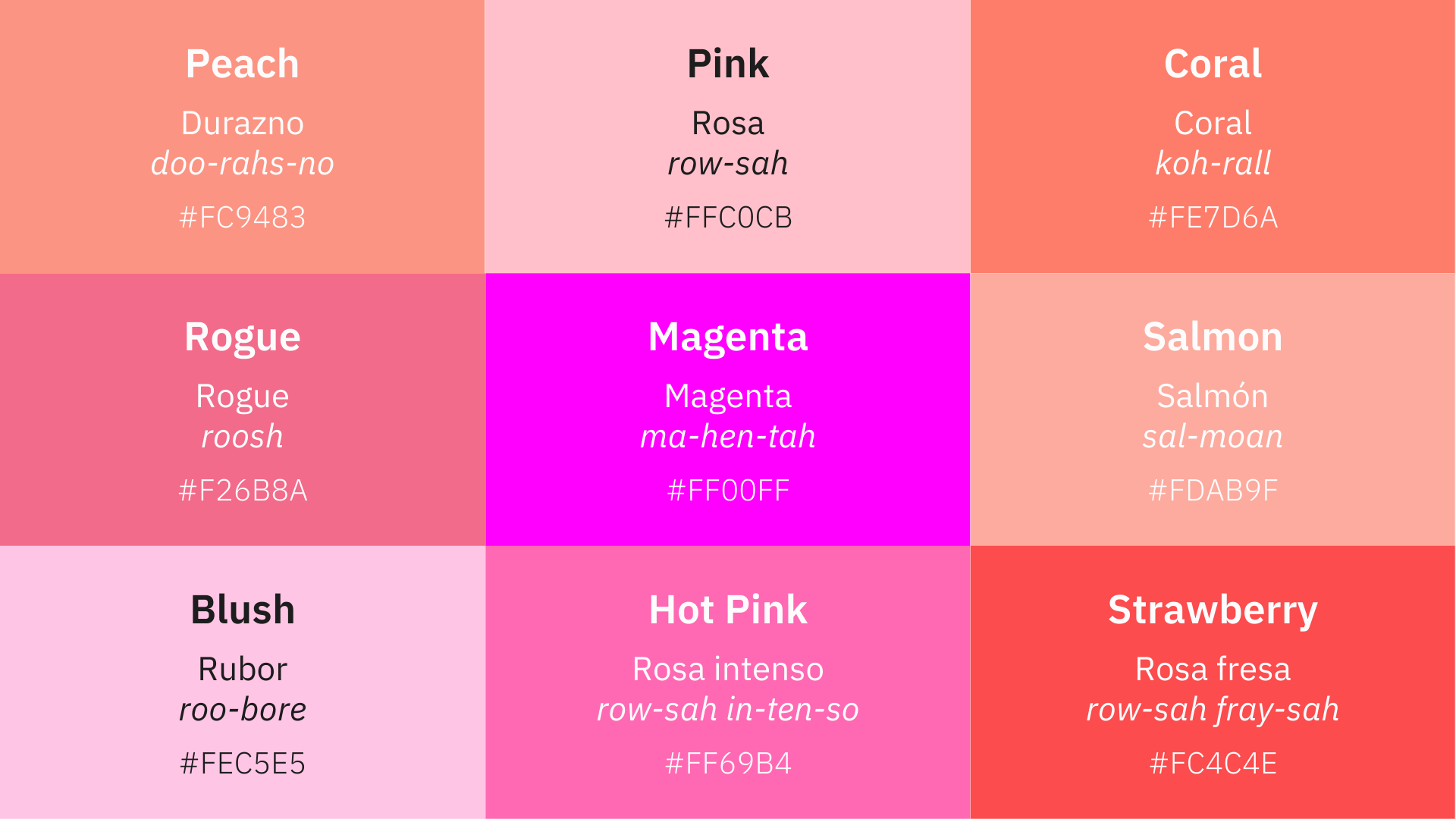Purple in spanish language – Unveiling the enchanting world of purple in the Spanish language, this discourse embarks on an exploration of its historical roots, cultural significance, and vibrant manifestations in art, literature, and everyday life.
From its etymological origins to its profound symbolism, purple has woven its way into the fabric of Spanish-speaking cultures, leaving an indelible mark on language, tradition, and aesthetics.
Etymology and Origin of the Word “Purple” in Spanish
The word “purple” in Spanish, “púrpura”, has a rich etymological history that traces back to ancient times. Its origins can be traced to the Greek word “porphyra”, which referred to a type of mollusk that produced a highly prized purple dye.
In ancient Greece, purple was a highly valued color, associated with royalty and power. The dye was extracted from the mucus of the murex snail, and the process was laborious and expensive. As a result, purple garments were only affordable to the wealthy and elite.
Evolution of the Word’s Meaning
Over time, the meaning of “púrpura” in Spanish has evolved. While it initially referred specifically to the color produced by the murex snail, it gradually came to be used more broadly to describe any shade of deep red or violet.
In modern Spanish, “púrpura” is commonly used to refer to a range of colors, including shades of violet, magenta, and burgundy. It is also used to describe the color of certain objects, such as the purple heart, a military decoration awarded to those wounded or killed in action.
Cultural Significance of Purple in Spanish-Speaking Countries

In Spanish-speaking cultures, purple holds a rich and varied significance. It is associated with royalty, luxury, and religious devotion, as well as with more somber emotions like sadness and mourning.
Throughout history, purple has been a color reserved for the elite. In ancient Rome, only senators and emperors were allowed to wear purple garments. This association with power and authority continued in the Spanish Empire, where the color became a symbol of the monarchy and the nobility.
Art and Literature
In Spanish art, purple is often used to depict religious figures, particularly those associated with the Virgin Mary. The Virgin’s cloak is frequently depicted in a deep, rich purple, symbolizing her purity and her role as the Queen of Heaven.
In Spanish literature, purple is often associated with melancholy and sadness. The poet Federico García Lorca, for example, frequently used the color in his works to evoke a sense of loss and longing.
Traditional Practices
In some Spanish-speaking cultures, purple is also associated with mourning. In Mexico, for example, it is customary to wear purple clothing during the Day of the Dead celebrations, which honor the deceased.
In other Spanish-speaking regions, purple is used in traditional festivals and celebrations. In Guatemala, for example, the color is associated with the Mayan deity Ix Chel, and it is used in traditional textiles and costumes.
Shades and Variations of Purple in Spanish
The Spanish language boasts a rich tapestry of purple hues, each with its own distinct shade and cultural significance. From the vibrant moradoto the ethereal lila, these variations of purple add depth and nuance to the Spanish language.
Subtle Shades
- Lila:A delicate and pale shade of purple, reminiscent of the soft petals of lilacs. It conveys a sense of tranquility and innocence.
- Lavanda:A soothing shade of purple that evokes the calming aroma of lavender. It is often used in contexts of relaxation and serenity.
- Malva:A soft and muted shade of purple, similar to the color of mallow flowers. It exudes a sense of warmth and comfort.
Vibrant Hues, Purple in spanish language
- Púrpura:A deep and regal shade of purple, often associated with royalty and nobility. It commands attention and conveys a sense of power and authority.
- Morado:A rich and saturated shade of purple, commonly used in traditional Spanish textiles and ceramics. It evokes a sense of passion, creativity, and spirituality.
- Violeta:A vivid and intense shade of purple, often associated with the color of violets. It symbolizes mystery, imagination, and intuition.
Purple in Spanish Literature and Poetry
Purple has played a significant role in Spanish literature and poetry, evoking a range of emotions, creating atmospheres, and developing characters. Its rich symbolism and evocative imagery have captivated readers for centuries.
Use of Purple Imagery and Symbolism
Purple has often been associated with royalty, luxury, and power in Spanish literature. In Miguel de Cervantes’s Don Quixote, for example, the knight’s beloved Dulcinea is described as wearing a purple dress, symbolizing her elevated status and the hero’s idealized love.
Purple can also convey emotions such as sadness, longing, and melancholy. In Federico García Lorca’s poem “Romance Sonámbulo,” the protagonist’s grief over her lost love is expressed through the imagery of purple flowers and a “purple moon.”
Purple in Character Development
Purple has been employed in Spanish literature to reveal and develop characters’ inner worlds. In the works of Isabel Allende, purple is often associated with female characters who are strong, independent, and passionate. In The House of the Spirits, for instance, the protagonist Clara del Valle’s purple eyes symbolize her rebellious spirit and her defiance of societal norms.
Purple in Spanish Art and Architecture
In the realm of Spanish art and architecture, purple holds a significant place, evoking a range of emotions and symbolizing various concepts. This vibrant hue has been employed by Spanish artists and architects throughout history to create captivating visual experiences, convey religious messages, and reflect cultural influences.
Painting
In Spanish painting, purple has been utilized to depict scenes of royalty, wealth, and power. During the Renaissance, artists such as El Greco and Bartolomé Esteban Murillo incorporated purple into their religious paintings to represent the garments of the Virgin Mary, symbolizing her humility and purity.
In the 19th century, Romantic painters like Francisco Goya used purple to evoke emotions of melancholy and despair in their works.
Sculpture
Spanish sculptors have also embraced purple, employing it in both religious and secular works. Polychrome sculptures from the Middle Ages often featured purple robes on religious figures, while in the 20th century, sculptors like Pablo Picasso incorporated purple into their abstract and Cubist creations.
Architecture
In Spanish architecture, purple has been used sparingly but effectively. Notable examples include the stained glass windows of the Sagrada Família in Barcelona, designed by Antoni Gaudí, where purple hues create a sense of awe and wonder. The Alcázar of Seville also features purple tiles in its intricate decorations, adding a touch of opulence and grandeur to the building.
Purple in Spanish Folklore and Traditions
Purple holds a significant place in Spanish folklore and traditions, embodying the supernatural and the extraordinary. It is associated with mystical beings, magical artifacts, and ancient beliefs.
Supernatural Beings
In Spanish mythology, purple is often attributed to supernatural creatures. The “duende,” a mischievous spirit, is said to have purple eyes. Witches and sorcerers are depicted wearing purple robes, symbolizing their connection to the otherworldly.
Magical Objects
Purple is also associated with magical objects. The “capa mágica” (magic cloak) is a recurring motif in Spanish folklore, granting the wearer the ability to fly or become invisible. Purple crystals and amulets are believed to possess protective powers and ward off evil spirits.
Traditional Beliefs
In some Spanish-speaking regions, purple is linked to traditional beliefs and superstitions. It is considered unlucky to wear purple on certain days, such as Holy Thursday, as it is associated with mourning and penance. Conversely, purple flowers are often used in traditional healing rituals, believed to have medicinal properties.
Purple in Spanish Music and Dance
Purple holds a significant presence in Spanish music and dance, both as a lyrical device and a visual spectacle.
Lyrical Symbolism
Purple often appears in Spanish lyrics to evoke emotions of longing, melancholy, and nostalgia. In flamenco, the soulful “cante jondo” style often employs purple imagery to express deep-seated pain and sorrow.
Cultural Identity
In traditional Spanish dance forms like flamenco and sevillanas, purple is a prominent color in costumes and accessories. The vibrant shade represents the passion and energy of these dances, while also connecting them to the cultural heritage of Spain.
Visual Spectacle
In modern Spanish music and dance performances, purple is used to create visually striking effects. Stage lighting and costumes often incorporate purple hues to enhance the atmosphere and convey the emotions and themes of the performance.
Purple in Spanish Fashion and Design

Purple has been a significant color in Spanish fashion and design for centuries. Its versatility allows it to be used to create both vibrant and elegant pieces. In clothing, purple is often used to create bold and eye-catching garments. Designers use it to add a touch of luxury and sophistication to evening wear and formal attire.
Purple is also popular in accessories, such as jewelry, scarves, and handbags. It can add a pop of color to an otherwise neutral outfit.
In home décor, purple is often used to create a sense of warmth and coziness. It can be used to create a relaxing and inviting atmosphere in living rooms and bedrooms. Purple is also a popular choice for kitchens and bathrooms, where it can add a touch of elegance and style.
Shades and Variations of Purple in Spanish Fashion and Design
There are many different shades and variations of purple used in Spanish fashion and design. Some of the most popular include:
- Morado:A deep, rich purple that is often used in formal wear and evening gowns.
- Púrpura:A lighter shade of purple that is often used in casual wear and accessories.
- Violeta:A bluish-purple that is often used in home décor and textiles.
- Lavanda:A pale purple that is often used in lingerie and sleepwear.
End of Discussion: Purple In Spanish Language

In conclusion, the multifaceted nature of purple in the Spanish language mirrors the richness and diversity of the cultures it has touched. Whether gracing the pages of literary masterpieces, adorning traditional attire, or inspiring architectural marvels, purple continues to captivate and enchant, leaving an enduring legacy that transcends time and space.
FAQs
What is the origin of the word “purple” in Spanish?
The word “purple” in Spanish, “púrpura,” traces its roots back to the Latin word “purpura,” which referred to a reddish-purple dye extracted from certain mollusks.
What cultural significance does purple hold in Spanish-speaking countries?
In many Spanish-speaking cultures, purple is associated with royalty, nobility, and religious authority. It is also seen as a symbol of mourning and remembrance.
How many shades of purple are there in Spanish?
The Spanish language recognizes several shades of purple, including “violeta” (violet), “lila” (lilac), “malva” (mauve), and “morado” (dark purple).